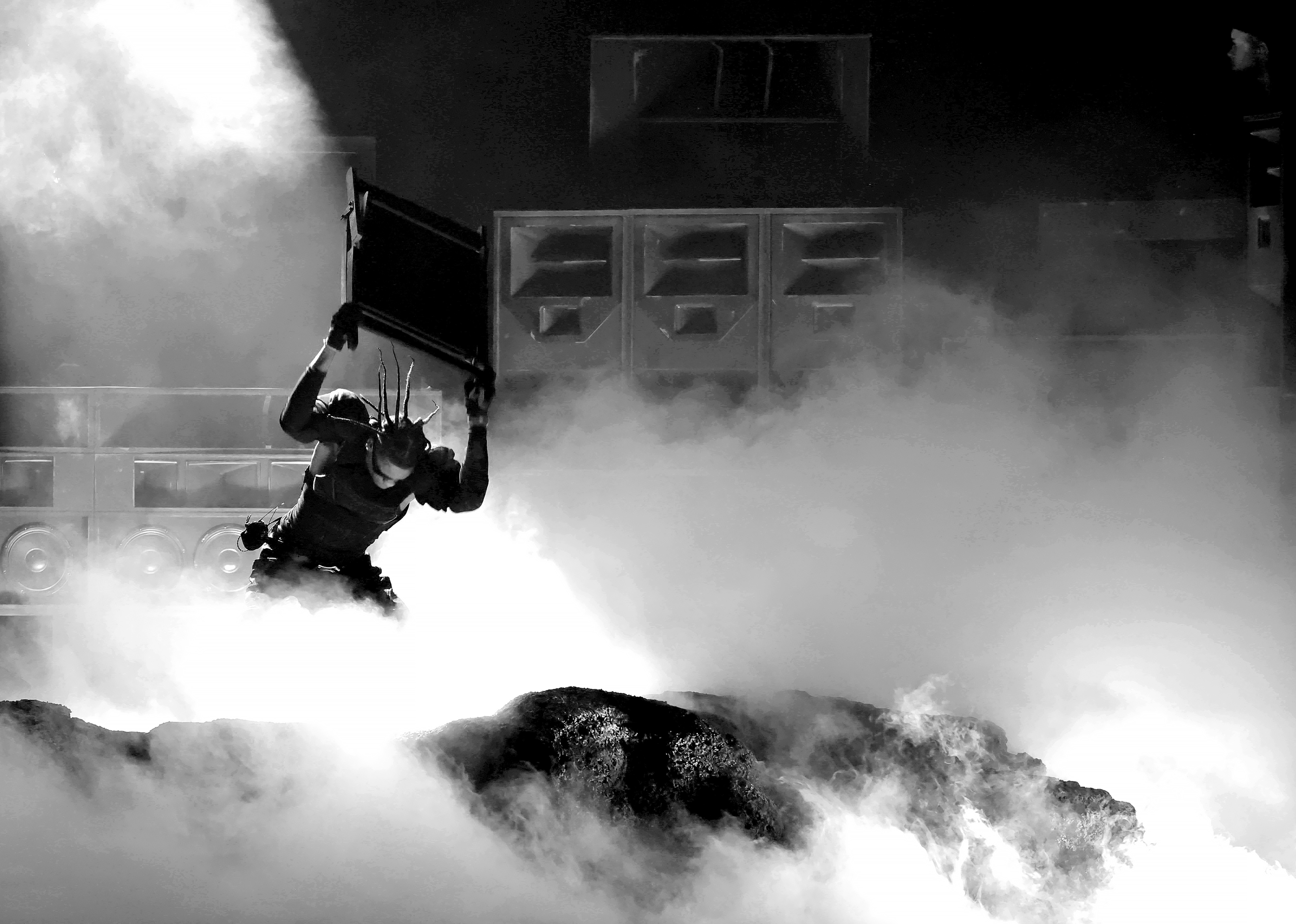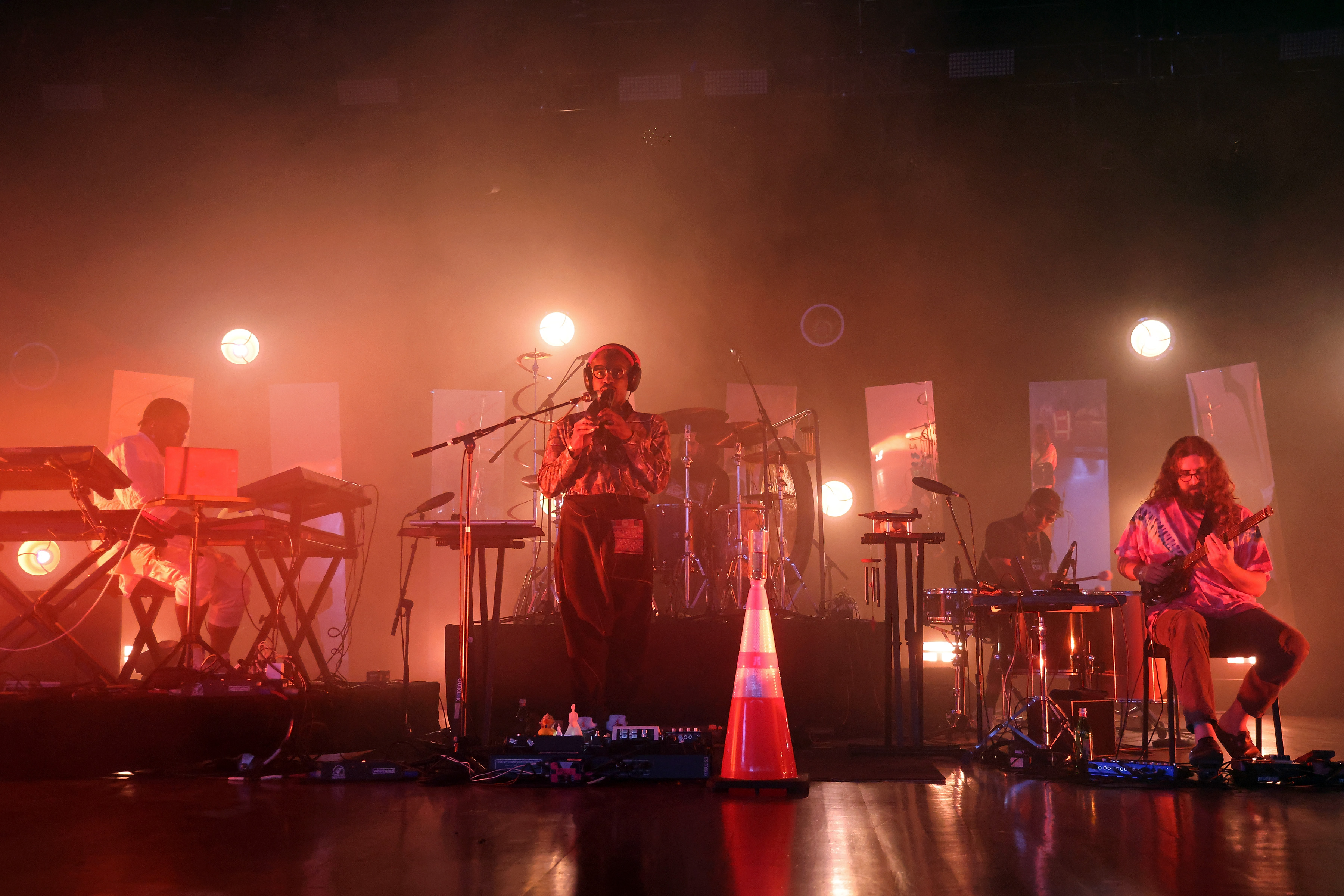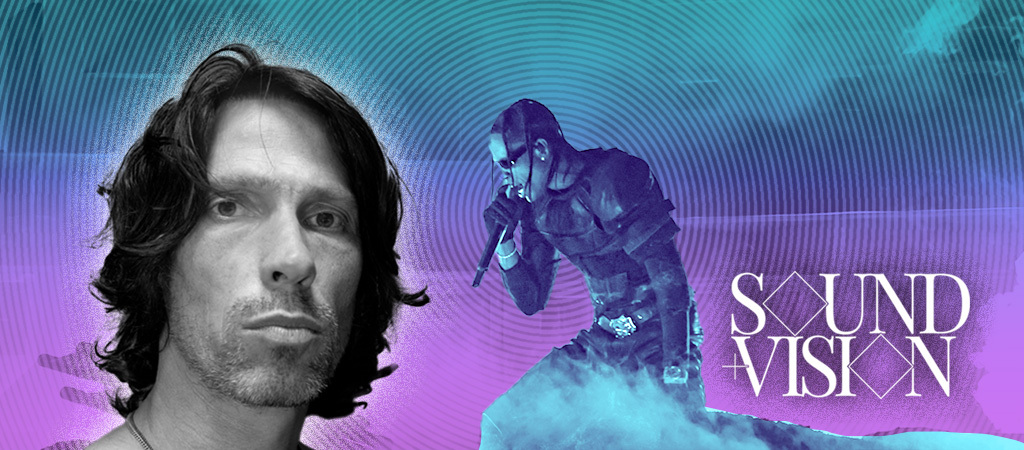Tino Schaedler has a vision for the future of concerts: It involves embracing the wonder, joy, and community at the heart of the live performance.
The German-born jack of all trades began his artistic career in architecture, before moving into film, brand design, and more. Now? He’s a go-to collaborator for many of the most inventive artists in music.
His work with acts like SAULT, André 3000, Travis Scott, and more earned him an honor at the 2024 UPROXX Sound + Vision Awards as the Vanguard Virtuoso, which “highlights visionary collaborators who empower artists and help drive music culture forward.” It’s clear through his varied approaches to stagecraft that there’s no one-size-fits-all method to his creations.
“The music industry has changed a lot since the pandemic, and there’s interest in really trying to create new types of live experiences and new types of experiences in general that are beyond stadium and arena tours,” Schaedler explained to UPROXX.
As such, he, and the artists he works with, have put an emphasis on live and lived experiences. Schaedler says that these aren’t disposable concerts where the lights go down, the band comes on, they play some songs, and they leave. He wants to re-imagine the way concerts can be experienced.
“We’re all on our phones all the time,” Schaedler explains. “I want to make bodies our interface again, putting people into the moment and being present.”
Where does your initial passion for art — or more broadly, creativity — stem from?
My mom really laid the foundation from an early age. I would come home from school and there was always paper and pens on the floor. My whole childhood, I remember just drawing. That was all I was doing. I don’t think it was a conscious decision, but I think she also built a little bit of a reward system around it, because she always made me draw for everyone: grandparents, aunts and uncles, and everyone got a little drawing from me. There was always appreciation around it. It really built this image where I always felt like I was an artist. There was no other choice. It was so natural for me because it was my passion, and I think there was a persona that was created around that from that early age on.
Did you go to school for art? What was your focus?
I studied architecture. That was a little bit of a compromise in the beginning, and my dad really pushed me for it. He was a real estate developer and he was like, “Do you want to do art? At least have it be something that has a bit of an economy behind it.” Back then, I always thought of it as a compromise, but in hindsight, it wasn’t really, because studying architecture gives you such a broad scope of education, from understanding the technical side of architecture to the spatial understanding and spatial imagination to art history, architectural history, and all of that.
A lot of what I do is still fed from that time, and it really influenced the way that I think about things. I studied at Berlin and then did two years at UC Berkeley, and there I learned about this landscape architect named Lawrence Helpin. It was a long time ago and computers were a new thing. I think I got my first email while I was at Berkeley, and I learned about this landscape architect that did a lot of design on the campus there. He was designing using a storyboard. He used a storyboard to design landscape architecture. Architecture was never an abstract shape. It was always a combination or a relationship between a camera movement and perception. I always thought about architecture in a very cinematic way
And that’s a pretty good way to describe what you do now, right?
When I have meetings with new clients and I explain the way that I think about things, it’s relevant because I studied architecture and that’s all about space and the physical and psychological dimension of space. If you go to the Pantheon in Rome, there’s an emotion attached to that. Creating space has a kind of poetic potential to really evoke an emotion.

What did you do after graduating?
After graduating, I went into film and I worked on big movies: Harry Potter, Charlie And The Chocolate Factory, V For Vendetta. I had this high school teacher who inspired me to get into film. In Germany, you have to write an essay to graduate high school, and I wrote mine on [Stanley] Kubrick and [Alfred] Hitchcock. It was always film, it was about thinking about architecture through the camera lens, then moving into film. It was a very natural progression.
I did most of those films in London, then moved to California and did more films while moving into music videos and commercials. I also became a partner in this experiential agency, which is all about consumer journey choreography and creating experiences. What I do now with SAULT is really about those three things. It’s space, it’s design, it’s storytelling. It combines movement and experience. The music industry has changed a lot since the pandemic, and there’s interest in really trying to create new types of live experiences and new types of experiences in general that are beyond stadium and arena tours.
I learned from some of the brand experiences that I did for Nike or for Apple or for Beats. There are some interesting ideas in there, especially when paired with the shift towards immersive experiences. The music industry is open and hungry for new ways of experiencing things. We’re all on our phones all the time. I want to make bodies our interface again, putting people into the moment and being present. There are things that I’ve been super interested in for the past 10 years.
What was that challenge for you in helping SAULT be the band that they wanted to be in a live setting?
It was a super interesting setup. I mean, I got the first call about a year ago in October. I got that call from Inflo, and there was an immediate connection of various interests about creating something very special, creating something that puts people into the moment. The whole mystique that they’ve built around the band was super interesting to me. I didn’t know him before. A mutual friend connected us, but from the first moment, there was this really deep connection with Flo. We were on the phone for the next two months.
I did a few trips to London and it was just a beautiful exchange. Everything was created in terms of the design, and the programming came through us talking and figuring out how we could do something that is different than your traditional show. Normally, you wait in the main space, suddenly the light goes off and the band performs, and then the light comes on again and everyone leaves. The idea was about creating a world that’s very cinematic. The idea of world building is inherent to movies, so when you’re working on Harry Potter, you design the whole world that fits these characters. World-building is an interesting aspect that I think is very relevant for music today.
A lot of musicians do it just by the persona that they create. Think about Daft Punk, Doja Cat, or Lady Gaga. We wanted to take that to the next level and not just have something on the stage that you look at. We wanted to create something that you walk through that you experience where you have a much stronger interaction with it. It wasn’t a traditional linear relationship of the audience looking at a stage, because we redefined it by putting the stage in the middle of the whole crowd. You’re walking through the stage, everything becomes one. The whole space is the stage, basically.
Do you have an overarching philosophy to the way you approach these projects? Or are you more chameleonic in the way that you work with the artist’s desires?
I think it’s a little bit of both. There are some artists where you just have to be what they need, and I can deliver that. I worked with Tyla recently and they just needed help with a few festival shows, and we just designed something that can live on the festival stage.
Then there are other artists like André 3000. I helped him with his last tour, and that one was super minimal. We decided on that because he just wants you to put your phone away and listen. We did that one with a laser that shoots through this glass of water, and it’s so iconic. André is always about, “Let’s strip away, let’s strip away.”

What do you think stage design can, or is meant to, achieve?
When I worked in commercials or music videos, there were always people asking me why I didn’t move more into directing music videos or commercials. There are so many young people, and I don’t think I have anything unique to offer. I can do a good job, but I don’t have anything that no one else has. Regarding music and what I bring to it, though, I think I have a unique thing to give. In an ideal scenario, we all want to align our life purpose. We all want to feel like what we do has an impact.
In an ideal scenario, you come to a point where your gift or your skill and your passion all align with some kind of ability to give back or to create something meaningful. I love creating these moments that people remember for a long time.
I was at Tate Modern a few weeks ago. I was invited by Little Simz, and during that panel afterwards, a lot of people came to me and spoke about my work. There are still a lot of people that hit me up about SAULT. That alone is proof that something really special was created. So, that is the sweet spot that I want to be in. Not every project offers that, but I think it’s getting to be the case more and more, because more artists are realizing that they can actually do something different. They can push it, and there’s almost a new typology of music experiences evolving.







